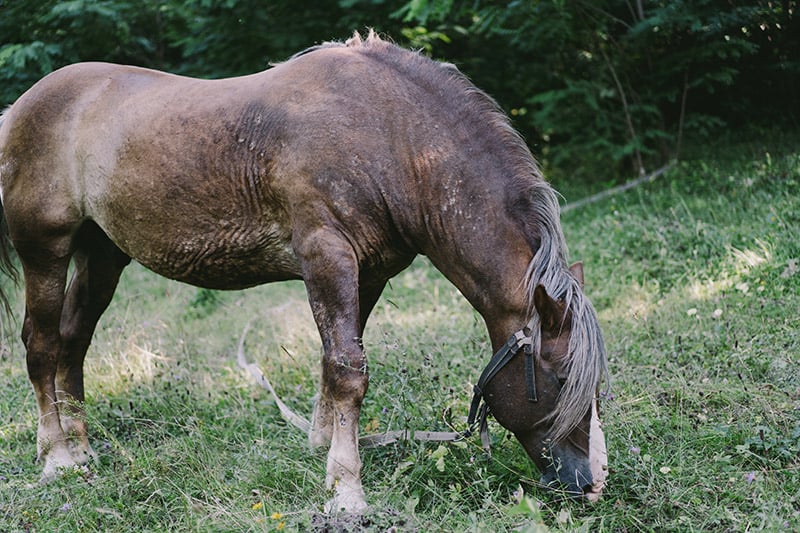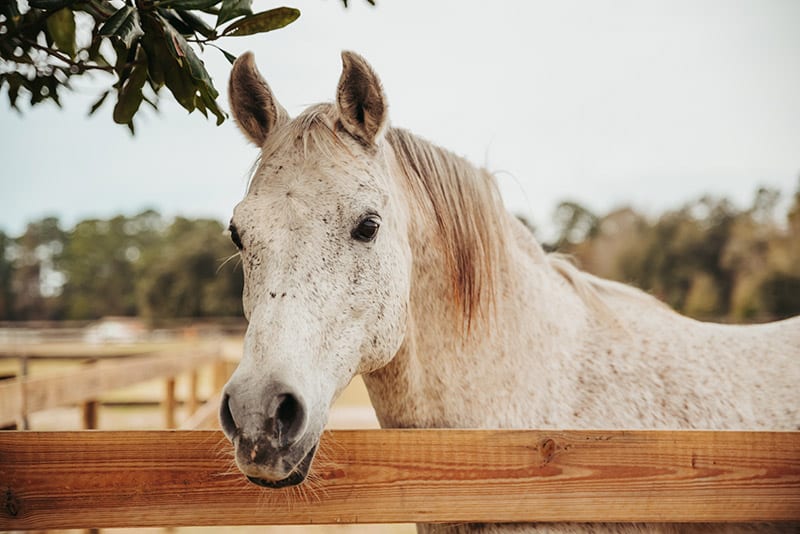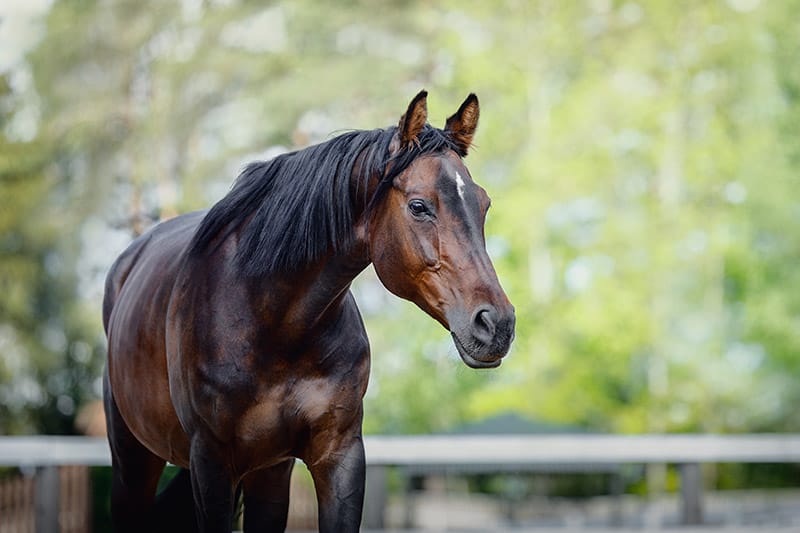Guest Author: Melissa Hathaway
Although horses can live active lives well into their twenties, with life expectancies of 30 years or more not uncommon, as they age horses’ needs change and they require more care and attention to keep them in good health. Some horse breeds do fare better in old age, with certain medical conditions more commonly affecting others. But here we consider a few care adjustments that can make the difference to your horse as they get older no matter which breed they are.
Preventing Weight Loss
Weight loss is a common sign of old age in horses. After the age of 20 many horses have difficulty digesting and absorbing sufficient food, and as a consequence their energy intake is insufficient to maintain their weight; this is often not helped by poor dentition. Horses will always appear visibly thinner as they age due to a loss of muscle mass, but a sagging abdomen – so often seen in older age – can give the impression that they are not losing weight. Rather than relying on eyesight alone, the best thing that owners can do is to feel their horse with their hands for signs of weight loss. If you feel that your horse has lost significant weight, having the vet check him over is a good idea. A number of medical conditions, particularly those of the liver and kidneys, can be a cause of weight loss.
Dental Problems
Years of grazing can considerably wear a horse’s teeth. While they can usually manage to still eat with teeth wear, uneven wear or gaps can cause bigger problems, such as abscesses and infection. If horses are unable to chew their feed it will pass through their gut without being digested. This can hinder absorption and increase their risk of colic. After the age of 15 horses should have their teeth examined every 6 months to prevent small changes to teeth developing into problems. Corrections can easily be made at this stage; leave it though and teeth will need to be extracted.

Changing Feeds
With age a horse’s energy and nutrient requirements change. Typically an older horse will require around 20,000 kcal to support a 1,000 lb body. A fibrous feed delivering one to two thousand calories per pound is ideal; grass is well suited in view of its ease to chew and digest, but obviously not if your horse is prone to laminitis. Grass hay, which is cut and baled prior to seed head formation, is preferable over mature grass and alfalfa; the latter is additionally high in calcium which can put strain on an older horse’s kidneys. Protein requirements rise to around 12 to 14% of their dietary intake due to inefficient digestion. However, “senior feeds” for horses make the process of providing the correct nutrition for an aging horse easier. When changing your horse’s diet it is best practice to do so gradually to prevent any digestive upset.
Feeding Environment
If older horses are kept with younger counterparts, they can miss out at feeding time. They tend to eat for a shorter time and bolt their food, which increases their risk of choking and can further interfere with digestion. It is therefore best to separate older horses at mealtimes to provide them with some peace to take in sufficient food and to eat at their own pace.

Maintaining Comfort
Whilst aging can’t be stopped, you can help ensure that your horse is comfortable. Aspects of care, grazing, and exercise can be adjusted depending on your horse’s physical condition. Older horses are at increased risk of skin conditions, including infections and damage. With age their immune system is thought to deteriorate, putting horses at increased risk from attack by fungi and bacteria. Wounds also tend to heal less well. Regular grooming and examination can help you to identify skin problems early.
A Vitamin C supplement may also strengthen their immune system. Like people, older horses struggle to regulate their temperature, particularly at the extremes. Make sure they have sufficient blankets and are stabled if necessary in the winter. Adequate dietary intake is also crucial for maintaining body temperature when it is cold. Equally it is particularly essential that older horses have access to shade in the summer and additional measures may be needed to keep them cool enough. Company is a must for older horses, but bossy youngsters may deny them what they need. Ponies and donkeys can therefore make better field mates for an aging horse. Regular exercise can help keep your horse in good shape and spirits. However in view of their changing physical condition, this should be at a lower intensity than previously and their health should be continuously monitored. Two or three times a week take them for a ride at a walk, trot, and short periods of slow canter would be ideal.

Maintaining Mobility
Wear and tear over the years can build up, making it more difficult to maintain good mobility in advancing years. While orthopedic problems can’t be cured at this stage, their symptoms can certainly be alleviated. Arthritis, which manifests itself as stiffness and pain in the joints, produces permanent changes to the bones. This is a result of wear, reduced joint fluid, and breakdown of cartilage. Agents that you apply to the joint and medications can both be prescribed by a vet; they will advise what your horse will benefit most from. Even when your horse has joint problems exercise shouldn’t stop; in fact it can aid their management. A horse that exercises regularly tends to see better results from prescribed treatments than one that doesn’t. However, a little and often approach to exercise is best employed; a few laps around the yard or ring will be enough at a time. Hoof growth slows with age due to reduced blood flow to the extremities and although this will mean that trimming and shoeing won’t be required as often, they may be in discomfort, so it is important that the farrier still regularly inspects their hooves.
Treating Diseases of Old Age
Some of the diseases that affect horses in their elderly years can also affect those at a younger age. While these conditions are often not fatal and can be managed to an extent through appropriate care, medications are often required in conjunction. It might be possible to obtain pet insurance for your horse that covers pre-existing conditions to help with the cost of treatment. Horses can develop a lung disorder called heaves, which worsens with age; dust and mold trigger inflammation in the lungs causing wheezing and shortness of breath. Removal of horses from an allergenic environment can sometimes cure heaves, while others require medication to control the lung inflammation. Glandular problems occur more commonly in older horses. Signs to look out for include a coarse coat that is not shed in summer, weight loss, excessive thirst, urination and sweating; these can all signal a problem with the pituitary gland in the brain, which controls other glands and many body processes. Pituitary tumors are a common cause of Cushing’s disease, which is characterized by abnormalities in fat and glucose metabolism, an imbalance of calcium and phosphate and enlarged adrenal glands. The latter is responsible for the trait appearance and behavior in Cushing’s disease. Horses with Cushing’s disease are also more prone to laminitis, infections and infestation with parasites. Keeping their coat short and keeping them away from lush grass can help prevent these. A variety of drugs are available, which can control pituitary secretions to help manage symptoms in Cushing’s disease.

Being vigilant for signs of disease in your horse, adapting their diet, changing their care, grazing and exercise routines, can all help to keep them comfortable and healthy in old age, allowing you to enjoy many more years together.
Animal-World has more on general horse care and horse health.
About the Author: Melissa Hathaway is a freelance writer involved with putting together helpful guides for pet owners. She owns two older horses herself!
Featured Image Credit: vprotastchik, Shutterstock
